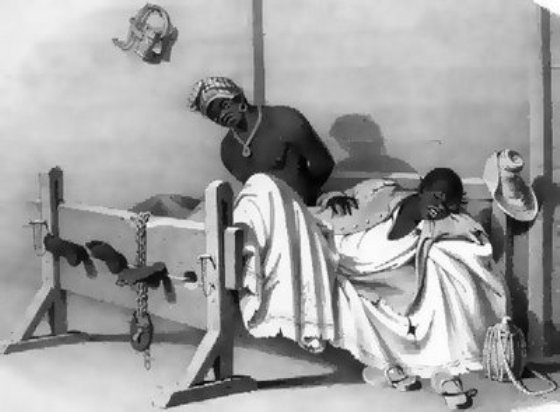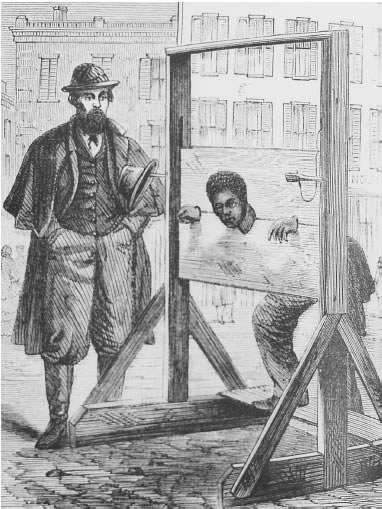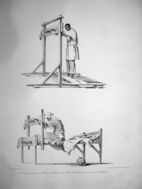 Another personal testimony made to the American
Anti-Slavery Society in 1839 concerning the fate of a slave who attempted to escape:
Another personal testimony made to the American
Anti-Slavery Society in 1839 concerning the fate of a slave who attempted to escape:  Stocks and pillories were regularly used to punish minor
offences committed by slaves. Although whipping was also a
common punishment, some owners were sparing with this for
fear of damaging or killing valuable slaves. Here is a personal testimony made to the American
Anti-Slavery Society in 1839:
Stocks and pillories were regularly used to punish minor
offences committed by slaves. Although whipping was also a
common punishment, some owners were sparing with this for
fear of damaging or killing valuable slaves. Here is a personal testimony made to the American
Anti-Slavery Society in 1839:
"A planter, a professor of religion, in conversation upon the universality of whipping, remarked that a planter in G--, who had whipped a great deal, at length got tired of it, and invented the following excellent method of punishment, which I saw practised while I was paying him a visit. The negro was placed in a sitting position, with his hands made fast above his head, and feet in the stocks, so that he could not move any part of the body. The master retired, intending to leave him till morning, but we were awakened in the night by the groans of the negro, which were so doleful that we feared he was dying. We went to him, and found him covered with a cold sweat, and almost gone. He could not has lived an hour longer. Mr.--found the 'stocks' such an effective punishment, that it almost superseded the whip.”
 Another personal testimony made to the American
Anti-Slavery Society in 1839 concerning the fate of a slave who attempted to escape:
Another personal testimony made to the American
Anti-Slavery Society in 1839 concerning the fate of a slave who attempted to escape:
"On the return of his master, some of the slaves were sent for Harry. When he came home he was seized and confined in the stocks. The stocks were built in the barn, and consisted of two heavy pieces of timber, ten or more feet in length, and about seven inches wide; the lower one, on the floor, has a number of holes or places cut in it, for the ankles; the upper piece, being of the same dimensions, is fastened at one end by a hinge, and is brought down after the ankles are placed in the holes, and secured by a clasp and padlock at the other end. In this manner the person is left to sit on the floor. Harry was kept in the stocks day and night for a week, and flogged every morning. After this, he was taken out one morning, a log chain fastened around his neck, the two ends dragging on the ground, and he sent to the field, to do his task with the other slaves. At night he was again put in the stocks, in the morning he was sent to the field in the same manner, and thus dragged out another week."
Stocks and pillories were on occasions used with particular savagery, as the following
illustrates:
“In the House of Commons on 1 July 1830, during the course of a speech on slavery in the colonies, an instance was mentioned of cruel treatment meted out by an English gentlewoman to a slave girl. On suspicion of being concerned in a theft, the young negress was imprisoned in the stocks for seventeen days, during which period she was deprived of sleep by rubbing red pepper into her eyes, and she was flogged repeatedly.” (“A History of Torture” by George Riley Scott)
Some more pictures of slaves in the stocks.

 Field stocks were much used as a means of punishing female slaves, when regulations substituting this form of punishment
in place of female flogging came into force. These consisted of stocks for the victim’s hands which could be adjusted to
any height above her head, while her feet were placed in horizontal stocks. The hand stocks could be raised and secured until
only the victim’s toes could touch the ground. The whole weight of her body rested upon her wrists and toes. In Trinidad,
to increase the punishment, leaden or iron weights were tied to the wrists.
Field stocks were much used as a means of punishing female slaves, when regulations substituting this form of punishment
in place of female flogging came into force. These consisted of stocks for the victim’s hands which could be adjusted to
any height above her head, while her feet were placed in horizontal stocks. The hand stocks could be raised and secured until
only the victim’s toes could touch the ground. The whole weight of her body rested upon her wrists and toes. In Trinidad,
to increase the punishment, leaden or iron weights were tied to the wrists.
The contemporary illustration on the left shows field stocks, and stocks attached to a bed. The text underneath reads:
"Stocks for hands and feet with bed, and hand stocks (from the approved models)".
This part relates to the abolition of flogging of female slaves in Trinidad: "....it is hereby further ordered and declared that all and every offence and offences which shall or may be committed by any female slave or slaves within the said Island of Trinidad and its several dependencies which....were punishable by flogging shall be....punishable by the adoption or infliction of one or other of the modes of punishment hereinafter mentioned:
1. Solitary confinement, with or without work, in any fit or proper place on any estate....
2. Field stocks, for the confinement of the hands during the hours of labour in the field, provided that for each offence the period of confinement shall not at any one time exceed thirty minutes.
3. Stocks for the hands only, during any period of the day; provided that for each offence the period of confinement shall not exceed six hours.
4. Stocks for the hands and feet during any period of the day, provided that for each offence the period of confinement shall not exceed three hours, and provided also that the said hands and feet stocks shall not be further apart than twenty-four inches, and shall be placed opposite to each other in parallel lines, and that in no case shall the hands of the slave be raised higher than her head.
5. Bed stocks, for the confinement of the feet during the day only...."
Source: British Parliamentary Papers: 1780-1849, Volume 46, Part 1
